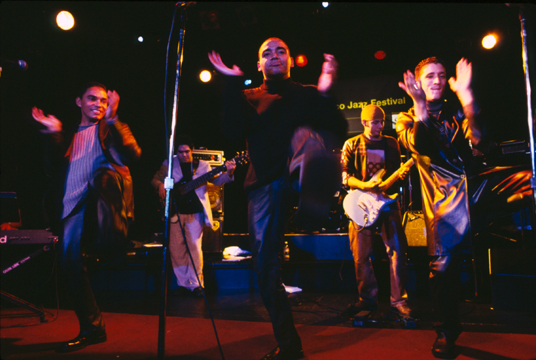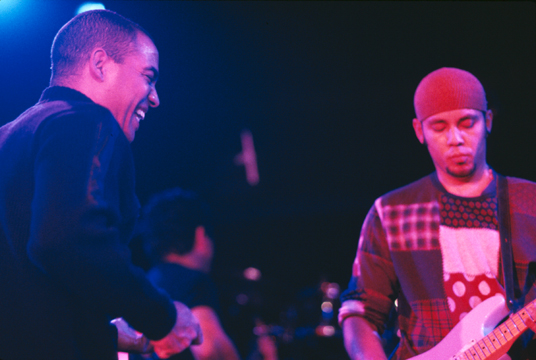Indice - Table of contents
New Stuff[hide]
Musicos: Rafael Paseiro Monzón
Musicos: Dennis Nicles Cobas
Musicos: Jiovanni Cofiño Sánchez
Musicos: Yasser Morejón Pino
Fotos: Tom Ehrlich : 2024 Monterey Jazz, P...
Resenas: Vacilón Santiaguero (Circle 9 ...
Staff: Bill Tilford
Fotos: Tom Ehrlich : 2024 Monterey Jazz, P...
Fotos: Tom Ehrlich : 2024 Monterey Jazz Fe...
Fotos: Tom Ehrlich : testing 123
Grupos: Pupy y los que S... : Discography - 1995- F...
Reportes: From The St... : Cubadisco 2...
Reportes: From The St... : Jazz Plaza ...
Fotos: Tom Ehrlich : Irakere 50th Annivers...
Photos of the Day [hide]
SpanishEnglishConc. Report - San Francisco Jazz - 2001

November 2 & 3, 2001
by Kevin Moore ©2001 - photography by Peter Maiden ©2001
Northern California got a deeply satisfying and long overdue dose of Timba this weekend as Manolín and his monstrous band tore it up in back-to-back sellout concerts at Bimbo's 365 Club as part of the San Francisco Jazz Festival. Of the over two dozen Timba shows scheduled in the Bay Area since Spring, only five have actually taken place, these two included. Originally booked for this week had been four shows by Bamboleo, two by Issac Delgado and a double bill of Orquesta Revé and Los Van Van -- all cancelled. For the last few years, the Bay Area has probably hosted more Timba shows per capita than any metropolitan area outside of Cuba, but with that glorious era having come to a screeching halt, it's very fortunate that one of the great Timba bands now resides in this country.
Manolín's highly-publicized defection to the U.S. last year reunited him with his original band, which had been in Miami since the summer of '99 when Manolín had earlier threatened to defect. Keeping up with Michael Jordan, El Médico's recent defection is his third (the first lasted only 2 days!), but this time around he appears to have burned his Cuban bridges once and for all, with the final straw, ironically, being a controversial coro about building a bridge from Havana to Miami.
When it became clear that he was really here to stay, it gave rise to a lot of speculation as to whether a Timba band could survive, commercially or artistically, outside of Cuba. In a larger sense, the jury is still very much out on both of these issues, but there's no doubt that this particular Timba band is alive and kicking, and playing with the same electrifying energy and precision that brought them to the pinnacle of popularity in Cuba.
The Band
In fact, a strong case could be made that this is Manolín's best band ever. It combines several young new stars with a battle-tested nucleus of musicians who've played together for over seven years in Cuba and around the world for crowds of up to 90,000. The result is a unit with more precision and discipline than most of the best bands currently on the island. The band was sounding great in August when I last heard them, but is now considerably better. The coro section has been reduced from an unruly four to just two -- Manolín's brother Lázaro and rising star Joaquín "El Kid" Díaz -- and they execute Manolín's unique and demanding coros with strong intonation and a very tight blend. The horn section, led by musical director/arranger Jeáns Valdés, was also noticeably tighter this time around. Pianist Eduardo "Chaka" Nápoles was his usual flawlessly brilliant self and keyboardist Luis Bu, who had left briefly, has returned to the band -- very welcome news. Bu was one of the original members and wrote many of the best arrangements, including "Somos lo que Hay" and "Me Pasé de Copas". The bassist, José Armando Gola, (son of Andy Gola, leader of "Colé Colé") has now been with the band for a couple years and plays powerfully and confidently, having memorized most of the material and only occasionally needing to grope for a shred of sheet music when an older tune from Manolín's large repoertoire is called unexpectedly. Gola can almost make me stop missing the original bassist, Victoriano Nápoles, whose punchy, compact, quintessentially "un-muddy" tone sets him apart from almost everyone. Nápoles was last seen somewhere in México. The newest member is guitarist Ahmed Barroso, who arrived from Cuba six years ago. Manolín, like Issac, has experimented for several years with Paulito's idea of using electric guitar in the Timba context. Barroso has a very compact, funky style that works very well and he played a great solo on a powerful Latin Jazz arrangement that the band played each night.

Manolin eggs on new guitarist Hamed Barroso
Finally, the percussion section has been reduced to only two people, unheard of in Timba. In Cuba, Manolín used drums, timbales, congas, and bongó. The current group has only congas and drums, but the two players are so overwhelmingly great that nothing else is necessary. Tomás Cruz played congas in Paulito's best group and has been in Miami for several years. He joined up with Manolín this summer and is arguably one of the best Timba congueros in the world. 19-year old drum prodigy Reinier Guerra left the Bay Area's percussionists gasping for air. He began his career at the age of 16 with Azúcar Negra before joining Manolín's band when the legendary "Pututi" brothers relocated to Miami in 1998. Guerra is an absolute wonder to watch -- he has a relentless free-flowing groove that sounds almost like one continuous fill, and yet never gets in the way of the arrangement. In a sense, it is the arrangement. On the first night Paulito alumnus Carlos Caro sat in for about half the set on campana bell. Caro had previously played a fiery set on timbales with local Timba stars QBA, who opened the show. If Manolín does return to three percussionists the third will probably be a bongocero as Guerra's powerful presence, like that of Samuel Formell (Los Van Van) or Roicel Riverón (Manolito y su Trabuco), makes a second timbalero superfluous.





















